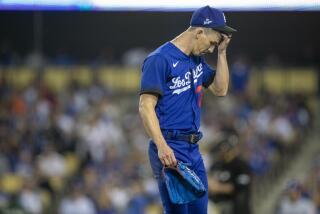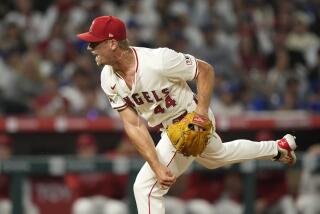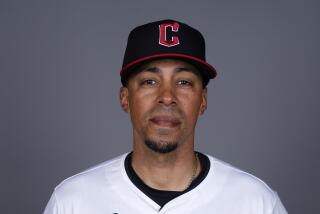Scioscia Uses Brain Power
- Share via
There is so much information available to managers, coaches and players, they would need a few gigabytes in their caps to store it all.
One service charts every pitch of every game--the kind of pitch, location, whether it was a ball or strike, where it was hit and how hard--and with such information, teams can chart how pitchers approach certain hitters and how batters hit certain pitches.
Manager Mike Scioscia studies the printouts.
“But you don’t want to have a computerized approach to pitch selection,” he said. “It’s more feel than science. You match a pitcher’s strengths with a hitter’s tendencies and choose your options the best you can. It’s based on memory.”
To help his catchers, in the first two weeks of spring training games Scioscia made them recall every pitch--in the order thrown--when they returned to the dugout after every inning. In the final two weeks in Arizona, he made catchers chart two innings at a time, which really tested their memory.
“I didn’t remember every pitch I called, but I remembered a lot more,” said catcher Matt Walbeck, who caught Kent Bottenfield’s seven-inning, five-hit effort in a 5-2 victory over Tampa Bay on Sunday. “It adds to your awareness, which helps.”
Scioscia believes such exercises will help his catchers guide Angel pitchers--especially youngsters such as Scott Schoeneweis and Ramon Ortiz--as they get deeper into the season and opponents’ knowledge of them grows.
“The league will basically let you know when you need to make adjustments,” Scioscia said. “Hopefully, if you mix pitches up and they’re not in a pattern, it will make it difficult to get a book on a guy. They may know his stuff but not his sequences. If you’re diverse enough and have enough tools, you won’t need to make huge adjustments.”
Changing speeds and hitting spots are most important for pitchers like Schoeneweis, Jason Dickson and Bottenfield, who won’t overpower opposing hitters, but so is mixing pitch patterns, keeping hitters guessing.
“I’m not going to an invent a pitch or throw anything different--it’s no secret what I’m trying to do, keep the ball down with all my pitches,” Schoeneweis said.
“But changing sequences helps, and Mike and Bud [Black, pitching coach] and the catchers are helping with that. It’s all part of learning how to pitch at this level.”
*
If it seemed that Bottenfield was throwing harder Sunday, it’s because he was. His fastball was about 86 mph most of April but hit 91 several times and was consistently around 89 mph as he struck out nine against Tampa Bay.
“The last couple of times out I’ve decided to be more aggressive,” Bottenfield said. “I wasn’t going to sacrifice location, but if I can throw harder, 88-91 mph instead of 84-87 mph, I think it will help.
“I felt stronger as the game went on, I felt confident, and I was still hitting my spots.”
*
Tim Salmon was batting .207 with eight RBIs when he stepped to the plate in the 13th inning Saturday night, a cold start that was frigid by even his standards (.275 lifetime average in April).
The cleanup batter then belted reliever Jeff Sparks’ fastball over the wall for a walk-off homer and a 7-6 victory over Tampa Bay.
“When you’re struggling, you’re looking for that one at-bat to turn things around,” said Salmon, who had an RBI single in Sunday’s victory. “Hopefully, that was it.”
More to Read
Go beyond the scoreboard
Get the latest on L.A.'s teams in the daily Sports Report newsletter.
You may occasionally receive promotional content from the Los Angeles Times.







